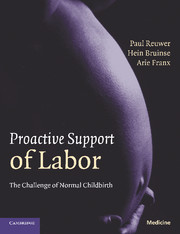Book contents
- Frontmatter
- Contents
- Foreword
- Acknowledgments
- Web-Forum
- 1 General introduction
- Section 1 A wake-up call
- Section 2 Back to basics
- Section 3 Proactive support of labor
- 12 Introductory synopsis
- 13 Nulliparous versus parous labor
- 14 Diagnosis of labor
- 15 Prevention of long labor
- 16 Personal continuity and continuous support
- 17 Amniotomy and oxytocin
- 18 Labor pain in broader perspective
- 19 Prelabor preparation
- 20 Medical pain relief revisited
- 21 Dynamic dystocia unraveled
- 22 Mechanical birth obstruction
- 23 Curtailed use of induction
- 24 Intrapartum care of the fetus
- 25 Prevention of litigation
- 26 Organizational reforms
- 27 Continual audit and feedback
- 28 Quality assessment
- 29 Hospital statistics
- 30 Sum of the parts
- Index
- References
26 - Organizational reforms
Published online by Cambridge University Press: 08 September 2009
- Frontmatter
- Contents
- Foreword
- Acknowledgments
- Web-Forum
- 1 General introduction
- Section 1 A wake-up call
- Section 2 Back to basics
- Section 3 Proactive support of labor
- 12 Introductory synopsis
- 13 Nulliparous versus parous labor
- 14 Diagnosis of labor
- 15 Prevention of long labor
- 16 Personal continuity and continuous support
- 17 Amniotomy and oxytocin
- 18 Labor pain in broader perspective
- 19 Prelabor preparation
- 20 Medical pain relief revisited
- 21 Dynamic dystocia unraveled
- 22 Mechanical birth obstruction
- 23 Curtailed use of induction
- 24 Intrapartum care of the fetus
- 25 Prevention of litigation
- 26 Organizational reforms
- 27 Continual audit and feedback
- 28 Quality assessment
- 29 Hospital statistics
- 30 Sum of the parts
- Index
- References
Summary
Proactive support of labor is an integral concept of childbirth consisting of five strongly interdependent components: prelabor education, psychological support, prevention of prolonged labor, constant peer review, and sound organization. It would be naive to expect that full implementation of the system could be achieved overnight. As with all major undertakings in health care and beyond, organization makes all the difference between success and failure. Unlike the situation today, wherein the organization directs the content of offered care, the demands of quality care should direct the organization. Most importantly, frontline birth professionals rather than managers should take the lead in the much-needed reforms. Sound organization needs to be considered at three levels:
The labor and delivery ward
Cooperation between nurses, midwives, and physicians
Replacement of provider-centered care by woman-centered care
The labor and delivery ward
“Many delivery units are so disorganized – unable to cope with additional pressures even though overstaffed for much of the time – that there is no possibility of providing efficient and high-quality care.” Nursing services often function in a largely fragmentary manner, usually heavily concentrated in daylight hours. Several doctors come and go, leaving capricious or even contradictory instructions. Residents, midwifes, and nurses are frequently placed in the invidious position of having to apply different methods of care, in exactly the same clinical circumstances, for no reason other than that the names of the obstetricians printed on the chart are different.
- Type
- Chapter
- Information
- Proactive Support of LaborThe Challenge of Normal Childbirth, pp. 230 - 240Publisher: Cambridge University PressPrint publication year: 2009



